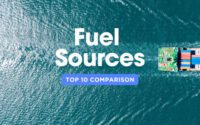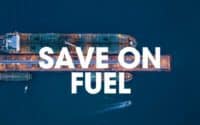Top 12 Cold Weather Tips to Slash Fuel Costs for Your Fleet

As we head into colder months, ship owners face unique challenges that can significantly impact operational costs, particularly in fuel consumption. Cold weather conditions, including icy waters, strong winds, and low temperatures, can all contribute to higher fuel usage. However, with the right strategies, ship owners can mitigate these effects, ensuring their vessels operate efficiently even in the harshest winter environments. Today we explore the top strategies to optimize fuel consumption during cold weather, offering practical solutions to help keep costs down while maintaining safety and performance.
1. Optimized Weather Routing and Voyage Planning
- Fuel Burn: Navigating through rough seas and against strong winds increases resistance against the ship, forcing engines to work harder and burn more fuel. Additionally, detours around storms or ice can lengthen voyages, further increasing fuel consumption.
- How to Save Fuel:
- Leverage Weather Routing Systems: Use advanced systems to predict storms, wind patterns, and ice formation, allowing you to choose the most fuel-efficient route.
- Avoid Rough Seas: Plan routes that steer clear of bad weather to reduce the resistance the ship faces, which lowers fuel use.
- Utilize Favorable Currents: Choose paths that take advantage of ocean currents to assist in propulsion, reducing the engine's workload and thus fuel consumption.
2. Slow Steaming and Speed Reduction
- Fuel Burn: Operating at high speeds in rough seas, icy waters, or against strong headwinds significantly increases drag and engine load. This results in higher fuel consumption as the engine works harder to maintain speed.
- How to Save Fuel:
- Reduce Speed in Tough Conditions: Slow down when navigating rough seas or icy waters to decrease the engine’s workload and fuel burn.
- Minimize Engine Strain: Operating at lower speeds reduces the strain on the engine, leading to significant fuel savings.
- Enhance Safety: Slower speeds allow for more stable navigation in unpredictable winter weather, reducing the risk of damage.
3. Advanced Hull and Propeller Maintenance
- Fuel Burn: Ice accumulation, biofouling, and debris on the hull and propellers increase drag, forcing the engine to use more power—and therefore more fuel—to maintain speed and efficiency.
- How to Save Fuel:
- Regular Hull Cleaning: Keep the hull clean to minimize drag, especially before entering colder regions where ice can form.
- Prevent Ice Build-Up: Consider applying specialized coatings to the hull and propellers to prevent ice accumulation, reducing drag and fuel usage.
- Ensure Propeller Efficiency: Regularly check propellers for ice and debris, ensuring they operate at peak efficiency to save fuel.
4. Fuel Heating and Viscosity Management
- Fuel Burn: In cold weather, fuel—especially heavy fuel oils—becomes more viscous, making it harder to pump and atomize properly in the engine. This leads to inefficient combustion, which requires more fuel to produce the same amount of power.
- How to Save Fuel:
- Pre-Heat Fuel: Use fuel heating systems to maintain optimal fuel viscosity, ensuring better atomization and more efficient combustion.
- Insulate Fuel Lines: Insulate fuel lines to prevent the fuel from cooling down as it moves through the system, reducing the need for excessive heating and thus saving energy.
- Monitor Fuel Temperature: Regularly monitor and adjust fuel temperature to maintain ideal conditions for combustion, reducing fuel waste.
5. Energy-Efficient Auxiliary Power Management
- Fuel Burn: Cold weather often necessitates increased use of auxiliary engines to power heating systems and other essential equipment, leading to higher fuel consumption.
- How to Save Fuel:
- Optimize Auxiliary Engine Use: Manage auxiliary engines efficiently by turning them off when not needed and optimizing load sharing between them.
- Implement Energy-Saving Measures: Use LED lighting and efficient heating systems to reduce the load on auxiliary engines, which can lower overall fuel consumption.
- Consider Battery Storage: Where applicable, use battery storage systems to supplement auxiliary power, reducing reliance on fuel-powered engines during low-load periods.
6. Ballast Water Optimization in Cold Conditions
- Fuel Burn: Improper ballast water management can lead to increased drag and reduced stability, forcing the engine to work harder and burn more fuel to maintain speed and balance.
- How to Save Fuel:
- Optimize Ballast Distribution: Ensure that ballast water is distributed in a way that minimizes drag and optimizes the ship’s stability and trim.
- Prevent Ballast Freezing: In cold regions, prevent ballast water from freezing, as ice can create additional drag and imbalance, increasing fuel consumption.
- Regular Ballast Checks: Conduct regular checks and adjustments of ballast water to maintain optimal ship performance and fuel efficiency.
7. Use of Icebreaker Assistance in Icy Waters
- Fuel Burn: Navigating through ice-covered waters without assistance significantly increases drag on the hull, requiring much more engine power and fuel to maintain speed.
- How to Save Fuel:
- Utilize Icebreaker Ships: When navigating in heavily iced areas, use icebreakers to clear a path. This reduces the resistance faced by your ship, allowing for smoother sailing and less fuel consumption.
- Coordinate with Local Authorities: Work with local maritime authorities to schedule icebreaker assistance when necessary, ensuring safe and efficient passage through icy regions.
- Plan Routes with Icebreaker Support: Incorporate icebreaker-assisted routes into voyage planning to avoid unnecessary fuel burn when traveling through ice-laden waters.
8. Engine and Propulsion System Optimization
- Fuel Burn: Cold weather can cause engine components to operate less efficiently due to increased viscosity of lubricants and fuel, leading to incomplete combustion and higher fuel consumption.
- How to Save Fuel:
- Use Cold-Weather Lubricants: Switch to lubricants designed for cold weather to ensure that all moving parts operate smoothly, reducing friction and improving engine efficiency.
- Optimize Fuel Combustion: Regularly check and adjust the engine’s combustion settings to account for cold weather conditions, ensuring complete combustion and reducing fuel waste.
- Maintain Propulsion Systems: Ensure that propellers and other propulsion components are free of ice and debris, and consider using propeller coatings that prevent ice formation, which can significantly improve efficiency.
9. Cold Weather-Specific Preventive Maintenance
- Fuel Burn: Cold temperatures can cause wear and tear on engine components and other systems, leading to inefficiencies that increase fuel consumption.
- How to Save Fuel:
- Conduct Regular Inspections: Perform frequent inspections of engines, fuel systems, and other critical components to identify and address issues caused by cold weather before they lead to inefficiencies.
- Replace or Upgrade Components: Consider upgrading to components that are better suited to cold weather, such as winter-grade fuel filters, to ensure optimal performance and fuel efficiency.
- Proactive System Maintenance: Carry out maintenance tasks that specifically address the challenges posed by cold weather, such as checking for ice build-up in critical areas and ensuring all heating elements are functioning properly.
10. Energy-Efficient Heating Systems
- Fuel Burn: In cold weather, heating systems onboard ships are necessary for crew comfort and to prevent equipment from freezing, but they can significantly increase fuel consumption if not managed efficiently.
- How to Save Fuel:
- Upgrade to Efficient Heating Systems: Invest in modern, energy-efficient heating systems that require less power to maintain the desired temperature, reducing the load on the ship's power supply and saving fuel.
- Implement Zone Heating: Use zone heating strategies to only heat areas of the ship that are in use, rather than maintaining a uniform temperature throughout the vessel, which can significantly cut down on energy and fuel use.
- Utilize Waste Heat Recovery: Where possible, use waste heat from the ship's engines to supplement heating needs, further reducing the demand on fuel-powered heating systems.
11. Efficient Use of Auxiliary Systems
- Fuel Burn: Auxiliary systems, such as generators and other equipment, often require additional fuel, especially when operating under cold conditions where more power is needed for heating, lighting, and other functions.
- How to Save Fuel:
- Manage Auxiliary Load: Carefully manage the load on auxiliary systems by only operating them when necessary and at optimal levels. Avoid running multiple systems at once unless required.
- Optimize Generator Use: If your ship uses generators for power, optimize their operation by using the most efficient generator configurations for the current load and conditions, reducing unnecessary fuel consumption.
- Regular Maintenance: Ensure all auxiliary systems are regularly maintained and tuned to operate efficiently in cold weather, reducing the likelihood of fuel-wasting inefficiencies.
12. Technology Integration for Real-Time Monitoring and Adjustments
- Fuel Burn: Without real-time data, fuel inefficiencies can go unnoticed, leading to increased consumption as conditions change throughout a voyage.
- How to Save Fuel:
- Install Fuel Monitoring Systems: Use advanced fuel monitoring systems to track fuel consumption in real-time, allowing for immediate adjustments to optimize efficiency based on current conditions.
- Implement Automated Adjustments: Integrate systems that can automatically adjust engine settings, speed, and route based on real-time data, ensuring optimal fuel efficiency at all times.
- Data-Driven Decision Making: Use the data collected from these systems to make informed decisions about route changes, speed adjustments, and other operational parameters, minimizing fuel wastage during cold weather operations.
| ShipUniverse: Fuel-Saving Strategies by Percentage | ||
|---|---|---|
| Strategy | Estimated Fuel Savings (%) | Conditions for Maximum Benefit |
| Optimized Weather Routing | 5-10% | When avoiding storms and rough seas |
| Slow Steaming and Speed Reduction | 10-20% | In rough seas or against strong headwinds |
| Advanced Hull and Propeller Maintenance | 3-7% | After hull cleaning and ice prevention measures |
| Fuel Heating and Viscosity Management | 2-5% | With proper pre-heating and insulation |
| Efficient Auxiliary Power Management | 5-8% | When optimizing load and using efficient systems |
| Ballast Water Optimization | 3-6% | With proper ballast distribution and management |
| Use of Icebreaker Assistance | 7-12% | In heavily iced regions with icebreaker support |
| Engine and Propulsion Optimization | 4-8% | With winter-grade lubricants and regular checks |
| Cold Weather-Specific Maintenance | 2-5% | With proactive inspections and upgrades |
| Energy-Efficient Heating Systems | 3-6% | With zone heating and waste heat recovery |
| Efficient Use of Auxiliary Systems | 4-7% | With optimized generator and system use |
| Technology Integration | 5-10% | With real-time monitoring and automated adjustments |

Do you have a Maritime Product or Service that may be of interest to Shipowners? Tell us about it here!
Do you have feedback or insights? Please reach out to editor @ shipuniverse.com



